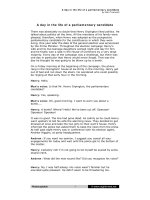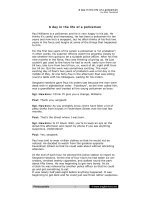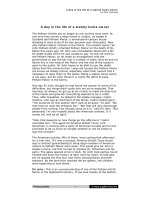Bài luận tiếng anh 2 ppsx
Bạn đang xem bản rút gọn của tài liệu. Xem và tải ngay bản đầy đủ của tài liệu tại đây (205.73 KB, 11 trang )
11
markets with that of Market C (Benchmark Market), where capital movements are known
to be free from restrictions.
By calculating a size of a band around the interest rate parity for each of the market
for A, B, and C, denoting each by TC
a
, TC
b
, and TC
c
, respectively, we could compare
each with the other two. Such comparisons will allow us to answer the three questions in
quantity terms and discuss related issues by identifying changes in capital control
measures and other factors that may have influenced changes in transaction costs.
III. Empirical Results
1: Deviations from Covered Interest Parity Condition: A Comparison
This section presents the empirical results of estimating transaction costs in three
markets, Market A, B, and C, by making use of the left hand side of equation (2) in the
previous section. The period for the empirical study is Q4 1999 through Q4 2004, which
was dictated by the availability of data for Market A, B, and C. For each market, sample
data are based on daily observation of the relevant spot exchange rate, the 3-month
forward exchange rate, the interest rate on 3-month local currency-denominated assets
and the interest rate on 3-month foreign currency-denominated assets.
10
The results of deviation from the interest rate parity condition for each of the three
markets are summarized in Figure 1 (Comparison of Deviation from Interest Rate Parity
Condition, Q4 1999 – Q4 2004). Several interesting points can be observed from this
figure.
First, deviations from the interest rate parity condition involving the Hong Kong
dollar and the U.S. dollar in Market C (Benchmark Market) fluctuated narrowly around
10
See Appendix II for details on the definitions and sources of data.
12
zero throughout the sample period, with an average quarterly rate of only 0.013 percent
(see column 1 in Table1).
11
This estimate is substantially lower than the estimate (0.06
percent) made by Clinton (1988) for the five Euro currencies mentioned above and the
estimate (0.13 percent) made by Frankel (1991) for Hong Kong during September 1982 –
April 1988. This comparison suggests that the efficiency of the market in Hong Kong
has improved considerably in recent years. Moreover, during the period under review,
the international capital market in Hong Kong (as far as the market for the Hong Kong
dollar and the U.S. dollar is concerned) was not subjected to a period of “currency
turmoil.” Therefore, it can be reasonably concluded that the transaction cost associated
with political risks for Hong Kong is negligible during this period.
Second, deviations from the parity condition in Market A (Onshore Market))
fluctuated somewhat more than those in Benchmark Market during Q4 1999 – Q4 2002.
Since then, however, deviations increased sharply through Q1 2004. This period
coincides with the period when speculation for the renmnbi appreciation increased
greatly. During Q2-Q3 2004, deviations from the interest rate parity dropped significantly,
but they again increased rapidly in Q4 2004.
Why was the pattern of movements in the deviations in Market A (Onshore
Market) so different between the period Q4 1999 – Q4 2002 and the period Q1 – Q4
2004? The answer seems to be the impact of the authorities’ efforts in encouraging
capital outflow and discouraging inflows in the latter period. Such efforts would tend to
create shortages of funds in the domestic economy relative to the amount that would have
11
Note that this estimate is about one tenth of the estimate made by Frankel (1991) for
the period, September 1982 – April 1988, indicating that the efficiency of the Hong Kong
market has increased further since the late 1980s.
13
been demanded by the economy in the absence of capital controls. This shortage then
would put upward pressure on the domestic interest rate.
12
However, this part is
expected to be negligible in the case of China because the Chinese authorities
administratively determined the interest rate on local currency-denominated deposits. As
a result, the arbitrage risk has increased. Moreover, they kept the spot exchange rate of
the renminbi against the U.S. dollar virtually unchanged throughout the period. As a
result, the exchange risk also has increased. Therefore, virtually all of changes in the
deviation from the parity would be reflected by changes in the cost stemming from the
political risks associated with the introduction of capital controls.
Third, deviations from the interest rate parity condition in the Cross-Border
Market were negative during Q4 1999 – Q1 2001, coinciding the period when the
authorities attempted to discourage outflows. Since then, the deviations became positive
and gradually increased.The rate of increase in the deviations and fluctuations are
similar to those in the Onshore Market. However, the magnitude (i.e. the absolute value)
of the deviation was greater than in the Onshore Market. This implies that the cost of
transactions for the Cross-Border Market is greater than that for the Onshore Market.
The difference indicates the additional cost incurred by taking funds across the border,
and ranged from 0.36 percent at the quarterly rate to 0.05 percent, with an average of 0.15
percent.
2: Estimated Impact of Changes in Capital Controls on Transaction Cost
Various changes that the Chinese authorities introduced to influence capital flows
would have different impact on transaction costs in different markets. In order to
12
See Otani (1983) for theoretical exposition of this point.
14
examine these differences in quantitative terms, we can compare estimated transaction
costs of different markets (Table 1).
The first three columns present deviations from the covered interest parity for the
three markets, A (Benchmark Market), B (Onshore Market), and C.(Cross-Border
Market). The negative values of the estimated transaction costs from Q4 1999 through Q1
2001 suggest that the authorities tended to take measures to retard capital flight. Since
then, the values of the estimated transaction costs by and large were positive, indicating
that the Chinese authorities discouraged capital inflows.
The fourth, the fifth, and the six column, respectively, present the absolute value
of deviations from the interest rate parity condition, which can be interpreted as the sum
of TCp and TCr for the respective markets. The seventh column represents the difference
between the estimated transaction costs in the Benchmark Market and those in the
Onshore Market, which can be regarded an approximation for the transaction costs
associated with broadly-defined political risks (i.e. TCr) for the Onshore Market, while
the eighth column the difference between the estimated transaction costs in the
Benchmark Market and the Cross-Border Market. The ninth column represents the
difference between the estimated TCr for the Cross-Border Market and the estimated TCr
for the Onshore Market.
The ninth column shows that, except Q2 2001, the transaction costs for the Cross-
Border Market are estimated to be greater than those for the Onshore Market. This
excess ranged from a quarterly rate of 0.05 percent to that of 0.23 percent. This difference
can be interpreted as additional transaction costs that changes in capital control measures
brought about for market participants in the cross-border market over and above those
15
that the same set of changes in the capital control measures brought about for the market
participants in the Onshore Market. Another point of interest is that the magnitude of the
impact of changes in the capital control measures has have waned over time, perhaps
indicating the evolving nature of changes that the authorities introduced over time. In the
earlier period, the Chinese authorities adopted the measures that they thought would have
greater impact on cross-border transactions, but they had to resort less potent measures as
time passed.
3: Effectiveness of Capital Controls on Illegal Capital Movement
If controls on capital movements were totally effective, or if there were no capital
controls, there would be no illegal movements of capital. However, if capital controls
were ineffective, illegal movements of capital take place and would normally show up as
components of errors and omissions in the balance of payments statistics. Of course,
errors and omissions also capture movements of statistical errors and omissions that are
not related to illegal movements of capital. Such statistical errors and omissions are not
expected to change dramatically from one period to another at least in the short term.
Therefore, large swings in errors and omissions are normally associated to movements of
speculative funds that move illegally across borders seeking unexploited profits. In this
context, errors and omissions could be regarded as a first approximation of such illegal
movements of capital.
Table 2 (China: Trade and Errors and Omissions, 1999-2004) shows data on
errors and omissions and their ratio to the value of trade (both exports and imports).
While the availability of such data is rather limited and they are not amenable to rigorous









